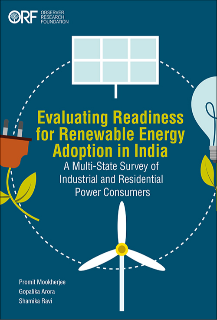The American public is more divided today than any time in modern history, as per the findings of a survey conducted by the Pew Research Centre, a Washington based think tank, said Dr. Bruce Stokes, Director at the Global Economic Attitudes.
Making a presentation on “How Americans see themselves and the world in the Trump era” at Observer Research Foundation on November 17, Dr. Stokes began by describing how public opinion had been divided since 1994 through an appraisal of several values-based questions.
First, in terms of explicating the dichotomous nature of public opinion Dr. Stokes highlighted two facets, with respect to both policy and non-policy aspects. Regarding the former, the survey finds that Democrats and Republicans are now more ideologically divided than in the last two decades. This was demonstrated in the Presidential election in 2016, where an overwhelming majority of Democrats, around 87%, mentioned that the US is less respected internationally as opposed to 42% of the Republicans. Further, the survey also suggests that there exists a growing partisan divide in other aspects in policy making, encompassing governance, race and immigration where the gap had widened during the current administration.
Another interesting terrain that factors into the divisive nature of public opinion is their difference concerning non-policy aspects. Dr. Stokes, based on the survey, elucidated that Republicans and Democrats have exhibited divisive attitude in terms of their geographical preference, personal relationships, notion of their elected officials and perception of each others which makes the partisanship deeply entrenched. This in turn complicates decision making within the American political system which is based on achieving a bipartisanship on the different issues.
Second, the survey captures the public perception in terms of the domestic economy which has been optimistic since the great depression, but subsequently puts forth the partisan divide. Corresponding to it, the Republicans hold a more positive view of the economy, as opposed to the democrats in the present time which confirms the concomitance between partisanship and the aspect of governance that made Dr . Stokes comment on the volatile nature of the democracy.
While understanding the context of public opinion during the present Trump administration, the survey finds that Trump had clocked the least approval rating, around 37% which is suggestive of the fact that he is the most unpopular President in the entire polling history. Moreover, the survey also depicts certain insightful trends within the demography in determining the public opinion, which found that Trump’s core supporters included mostly male, white evangelical protestants who by tautology were mostly Republicans. Further, according to most Americans, Trump is considered negatively in terms of certain personality traits, including honesty, temperament and has been judged to be prejudiced and selfish with no value for democratic institutions. The spill over effect of disapproval of Trump continues in the aspect of his policies comprising of the Paris Climate Agreement, withdrawal from FTA’s, Iran Nuclear Deal among others which only registers a split in terms of his Muslim ban.
In the trajectory of global affairs , Americans are united in determining that the North Korean nuclear crisis forms the major threat to their stability and security. However on a range of multiple aspects the partisan divide assumes prominence. For example, the survey finds that Democrats are more in favour of US engagement with its allies and support the inclusion of the allies’ interest in its foreign policy objectives. Another interesting aspect which registers the difference in opinion is that Democrats emphasises strongly on good diplomacy to ensure peace as opposed to resorting to military strength , where the Republicans favour Trump’s usage of force to defend its allies in the event of possible Chinese provocation . The preceding trend is also perceived terms of determining the public perception about the threat from North Korea where the majority of populace stated Trump is more likely to resort to force and that US should defend its Asian allies in the event of possible military confrontation with North Korea.
Another aspect where there is a significant division of opinion between the parties are the free trade agreements where Dr. Stokes, following the results obtained from the survey, mentioned that although in principle US has preferred them despite its protectionist trends, but it had been the Democrats who approve of them contrary to the Republicans.
Further, Dr. Stokes mentioned that public rely more on their local news organisations to obtain their information from as opposed to other forms of news sources, including social media organisations. He also points out the partisan split in the survey where Democrats hold a more optimistic position of the media, contrary to Republicans who feel that the media is prejudiced in its opinion .
The talk was followed by a stimulating question and answer session where Dr. Stokes highlighted that the disparity in public opinion was primarily due to the major demographic transition, that couldn’t accommodate the accelerating pace of the change, which in result witnessed backlashes both within the domestic and foreign policy sector of the US.
The idea behind Dr. Stokes’ presentation was to gauge the public mood in the US prevalent during the present Trump administration and how the discourse of public opinion is shaping up the US’s domestic and foreign policy priorities that is having an impact on the US’s engagement with the nations. The session was chaired by Prof, Harsh Pant, Distinguished Fellow and Head, Strategic Studies Programme, ORF.
This report is prepared by Sreeja Kundu, Research Intern, Observer Research Foundation
The views expressed above belong to the author(s). ORF research and analyses now available on Telegram! Click here to access our curated content — blogs, longforms and interviews.




 PREV
PREV

